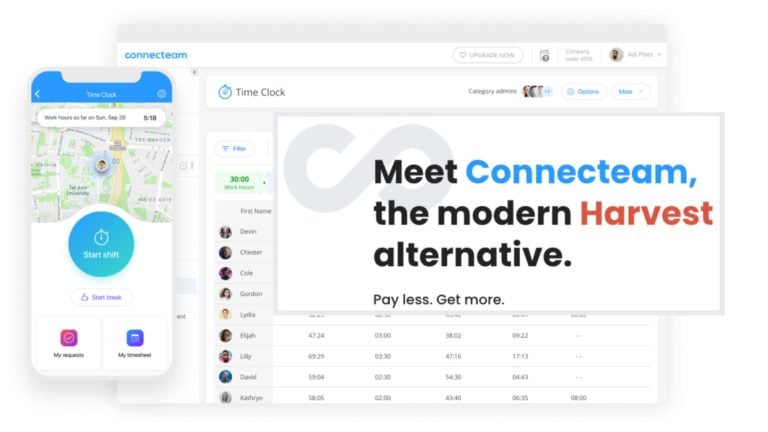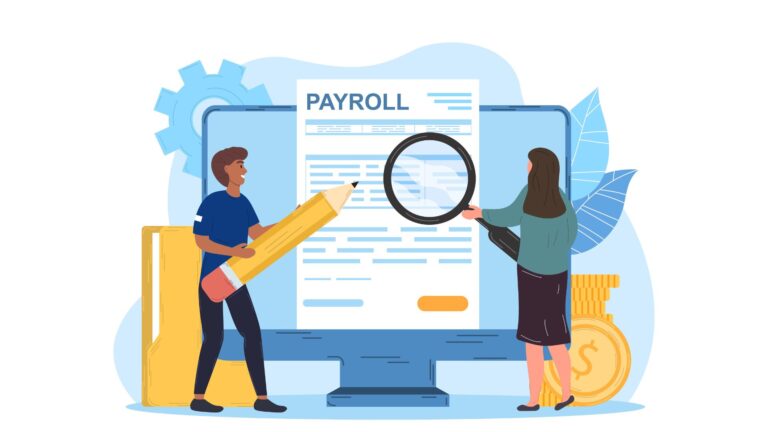Project and task management software helps you stay on top of deadlines, manage project resources, and avoid costly delays. In this article, we look at 7 alternatives to Trello, a popular project management software solution.
Task and project management tools help you allocate enough employees, time, equipment, and even money to deliver projects on time and to a high standard. They also improve communication and collaboration within your team, making it easier to complete tasks and meet deadlines.
Trello is a popular project management software, but it does have its drawbacks. Many are now looking for apps like Trello to help them manage their operations.
In this article, we take a look at 7 options for a Trello alternative, starting with the best of the bunch: Connecteam.
What Is Trello?
Trello, by Atlassian, is a project, workflow, and task management software and collaboration tool for teams of all sizes. It lets users create digital Kanban boards for their projects, with “cards” representing specific tasks.
Users can assign themselves or others to tasks, set deadlines, collaborate with team members in comments on cards, and more. As a task progresses, it can be moved across the board’s columns—which are lists of cards—until it’s complete. Images, notes, videos, files, and other attachments can be added to each card.
Users can receive real-time updates on tasks, such as when someone has been assigned to them or when new information is added to cards. Trello also lets users create checklists to add to tasks and automate certain workflows.
Our Top Picks
-
1
The best alternative to Trello
-
2
-
3

Why trust us?
Our team of unbiased software reviewers follows strict editorial guidelines, and our methodology is clear and open to everyone.
See our complete methodology
Why Are People Moving Away From Trello?
Like all software, Trello isn’t perfect and has received both positive and negative reviews from users.
Firstly, many describe Trello as simple and straightforward to use, but some note that this simplicity has limitations—especially for larger teams or complicated projects. One user explained that Trello’s simplified tools “can be lacking for more complex needs.” Another noted Trello may not be ideal for projects “that require advanced features like resource allocation, Gannt charts, or time tracking.”
While Trello offers a free version, several users find that it lacks features. For instance, there’s no calendar view available and limited reporting functionality, which reviewers have pointed out as downsides to Trello.
Additionally, many users have taken issue with Trello’s pricing, which they feel isn’t affordable.
“I feel the paid plans are too expensive, especially for larger teams,” one reviewer wrote.
While Trello is still a popular and generally well-rated project management tool, you may want to consider alternatives to Trello. Let’s take a closer look at some Trello competitors that can help you manage your business and projects.
The Best Trello Alternatives & Competitors for Project Management
-
Connecteam — The best alternative to Trello

Key Features
Full-feature desktop, mobile, and kiosk app
Real-time notifications
Pros
All-in-one project, employee, and operations management tool
Timing-saving automations to improve project workflows
Free-for-life plan for up to 10 employees
Intuitive and easy to use for managers and employees
Cons
More integrations in development
Connecteam is the best alternative to Trello—it’s an all-in-one solution to help you manage teams, projects, tasks, and so much more. Our app includes a range of tools to improve task management, project planning, and collaboration within your organization.
Tools to create and manage tasks with ease
Connecteam makes it easy to create and assign tasks in seconds. You can add due dates, subtasks, descriptions, images, files, and other attachments to tasks. This way, your employees can access the information they need to complete their tasks in one place. Additionally, you’re able to set common tasks to recur, saving you time and effort.
Within the Connecteam app, you have access to a central dashboard that provides an overview of all tasks. Tags let you filter tasks and view them based on their completion status, due dates, and the worker(s) responsible for them.
Forms and checklists ensure everyone stays up-to-date and productive
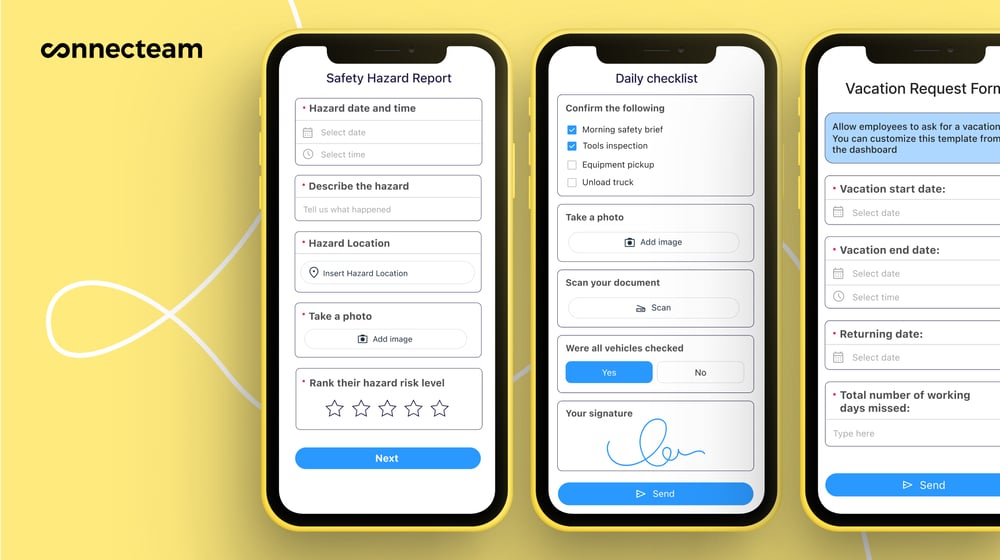
Connecteam also lets you create digital forms and checklists to help keep projects running smoothly without delay. You can use ready-made templates or make custom forms and checklists right from your mobile device. Then, send them to multiple locations instantly with just a few touches of your screen.
Connecteam also includes signature and geolocation features to keep employees accountable in completing forms. Employees can fill out forms and view and update checklists from wherever they are, whenever they’re working.
You can use the data from completed forms and checklists to generate project or task reports. These insights help you identify project inefficiencies, such as the over-allocation of resources, and address them to improve project management.
You might also be interested in reading our in-depth review of the best online checklists apps to help your small businessesIn-app chat for enhanced collaboration
Connecteam has a built-in chat feature that helps your team collaborate and communicate in real time no matter where or when you’re working. You can set up one-on-one and group chats and customize access permissions as you see fit. Messages can contain images, videos, audio notes, and more, and you’re able to favorite and mute chats as well.
There’s even a task-specific communication channel within Connecteam. Employees can ask questions within a task, so all relevant discussions are kept in an easy-to-find location.
Drag-and-drop tool for stress-free scheduling

Connecteam offers a drag and drop free employee scheduling app that helps ensure you have the right people rostered on when you need them. Schedule workers to shifts according to specified availability, certain qualifications, or even preferences. Or, set open shifts that any one of your workers can grab.
Perfect for project management, the scheduling tool also enables you to add tasks, checklists, and forms directly to your employees’ shifts.
You might also want to read our review of the best employee scheduling apps
Time tracking, GPS location tracking, and reporting for a better overview
Connecteam’s time clock allows for project, job, and client-specific time tracking, and records employee hours down to the second. They clock in and out with a single touch and add time entries manually if they forget to punch in. Connecteam can be used as an on-site kiosk app as well.
The time clock is GPS-enabled, allowing you to check employees’ on-the-clock locations to ensure they’re where they need to be. You can set up geofences around your office or any of your job sites as well. This prevents workers from clocking in or out outside of specific locations.
Connecteam also enables you to generate reports on labor costs, time spent on projects, and more. For project management purposes, you can view these insights to ensure you’re following business plans, not running over budget, and allocating money and resources properly.
Advanced notifications and smart alerts keep everyone in the loop
Connecteam’s notifications and alerts help ensure your team never overlooks a task or misses a deadline. Employees are automatically notified when a task is assigned to them. You can also set up push reminders for upcoming tasks and due dates. You’ll also receive notifications when employees complete a task.
When it comes to project management, these notifications help you and your team stay on schedule. They also save you from having to chase up your team, allowing you to focus on more pressing tasks.
So much more than just a project management solution
Connecteam is more than a simple task and project management tool. It’s an all-in-one workforce management platform with a suite of communication, people management, and operations tools.
As well as offering a free-for-life option—for small businesses with up to 10 employees, Connecteam’s paid plan starts at just $29 a month for up to 30 users. This makes it a budget-friendly option for teams of all sizes.
Connecteam also offers a free for life plan – Try Connecteam here!
Pricing
Free-for-life plan availablePremium plans start at $29/month for 30 users
14-day free trial, no credit card required
Start your free trial -
Asana —
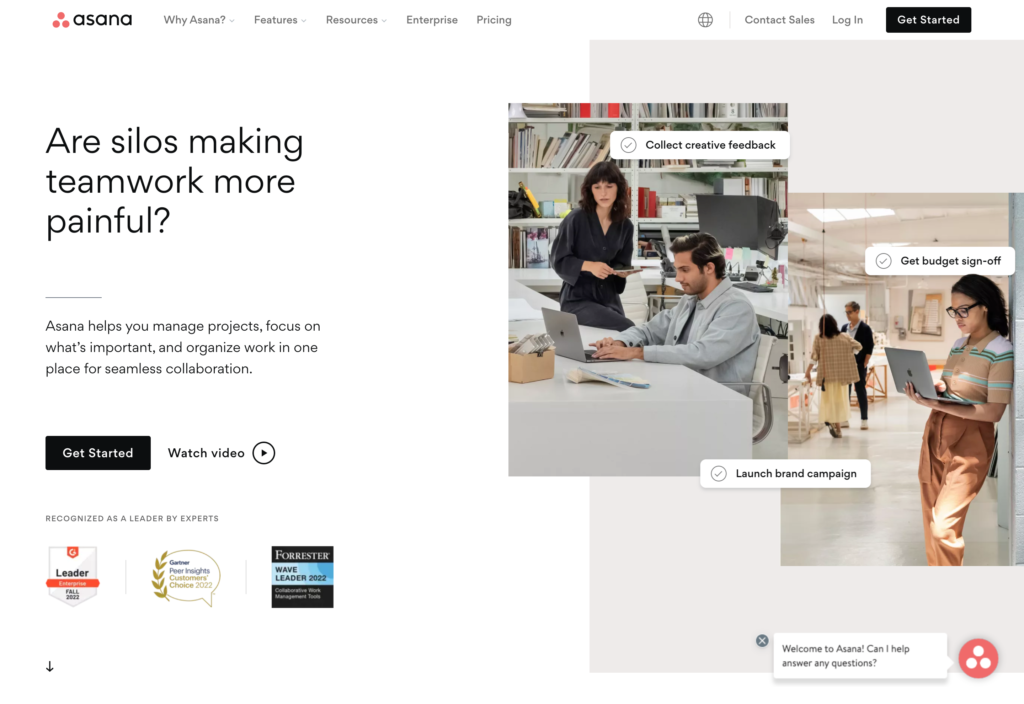
Key Features
- Time-tracking
- Customizable dashboards
- Custom project templates
- Forms feature to standardize work requests
Pros
- Various integrations available
- Free version available
Cons
- Per-user pricing can add up
- Free version has limited access to features
Asana is a Trello alternative that lets users manage projects across different departments or teams by providing a digital space to organize work, communicate, and collaborate. Asana can be used for a range of projects or tasks—including marketing campaigns, onboarding new employees, launching products, and more.
The platform allows users to create to-do lists, project plans, and Kanban boards. Asana also offers a range of views including calendar, timeline, and list views. In addition, managers can access reports for real-time updates on workflows to track tasks and deadlines. Workflows can be automated as well. Users can set up specific rules for automations—for example, when to update a task to a different status.
Pricing
Starts at $10.99/user/month Trial: No Free Plan: Yes — Up to 15 people
-

Monday.com —
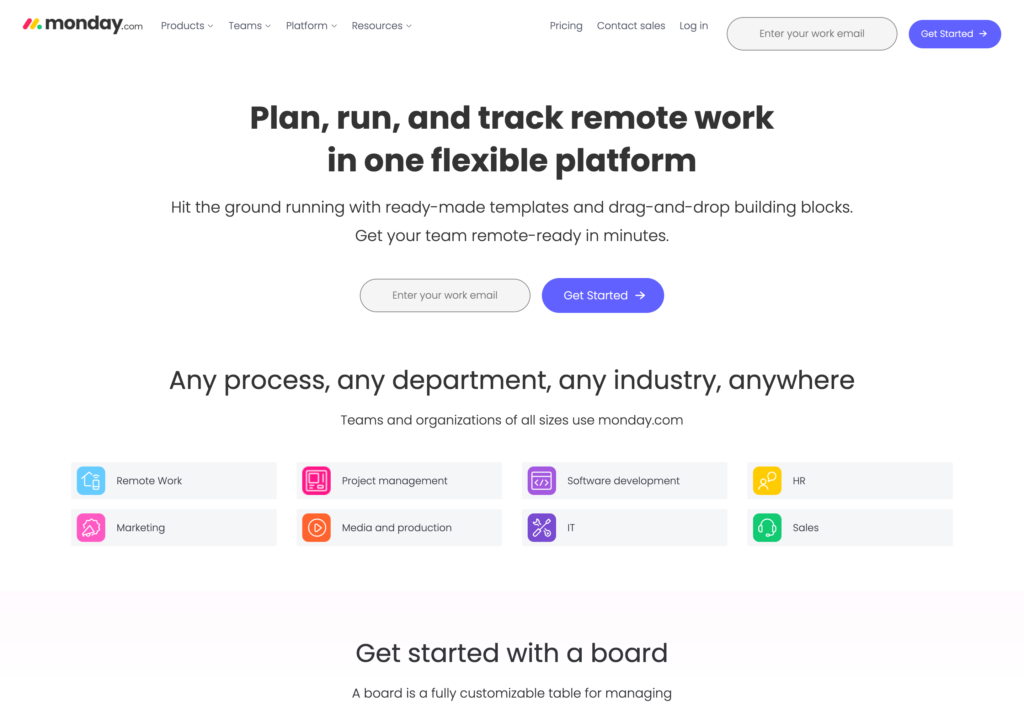
Key Features
- iOS and Android apps
- Gantt chart view
- Document sharing and organization
- User permissions
Pros
- 24/7 support available
- Clean user interface
Cons
- Can become pricier than other apps like Trello
- Time tracking feature only available with higher plans
Another one of the top alternatives to Trello, Monday.com is a workflow management platform that enables users to build no-code tools to manage their tasks and projects. The platform supports collaboration across various teams including marketing, sales, HR, operations, and IT.
Via a central dashboard, Monday.com lets users create projects, assign tasks, set timeframes, and track progress. It offers Kanban board, Gantt chart, timeline, and calendar views.
The platform includes automations, like sending users due date reminders and status updates on projects. It also offers time tracking and a feature that allows team members to collaborate on the same document.
Monday.com has a clean interface and is customizable to suit users’ specific needs, but it lacks some features in its free plan.
Pricing
Starts at $8/user/month Trial: Yes Free Plan: Yes
-

ClickUp —

Key Features
- Automatic progress tracking
- Project templates
- Two-factor authentication
- Customizable user access permissions
Pros
- 24/7 support included in all plans
- Free plan available
Cons
- Timesheets feature only available with higher plans
- Larger teams may find per-user pricing expensive
Clickup is a Trello alternative that offers productivity tools including task management, whiteboards, and dashboards. These features allow users to plan, manage, and track their projects.
Clickup is designed to support productivity and collaboration across departments within an organization. Users can set up spaces for different teams to manage their related workflows and information. This information is viewable in 15 different formats including list, Gantt chart, calendar, and mind map views.
Additionally, Clickup has a documents feature that enables users to collaborate on documents in real time and connect them to related tasks. The platform also offers a built-in chat feature for team members to communicate with one another.
Users can automatically import existing work into Clickup from other tools and files. They can also set up automations for recurring tasks.
Pricing
Starts at $10/member/month Trial: Yes — 15-days Free Plan: Yes
-

Basecamp —

Key Features
- In-app message board
- Project scheduling tool
- Document storage
- To-do lists
Pros
- 24/7 support for Pro Unlimited users
- Can directly link to other software products
Cons
- No free version
- No built-in time tracking—available as an integration
Next on our list of Trello competitors is Basecamp, which offers users a single platform to replace various individual project management tools. These include to-do lists and Card Table, a Kanban-like board. There’s also a scheduling feature to manage deadlines and project milestones.
Basecamp’s dashboard provides users with an overview of their projects and schedules, allowing them to pin priority projects. Its message board enables users to keep track of conversations and information relevant to a project.
Users can also store and share files on Basecamp and directly link to other apps or software, including Dropbox, Google Sheets, and Figma.
Unfortunately, Basecamp isn’t a free Trello alternative, as it doesn’t offer a free version. There are also no built-in time tracking tools.
Pricing
Starts at $15/user/month Trial: Yes — 30-75 days Free Plan: Yes — For one project
-

Airtable — Good for: Managing large amounts of data
Available on
- Web
- iOS
- Android
- Windows
- Mac

Key Features
- Various views including list, timeline, Kanban, and calendar
- Workflow automations
- Form building
- Integrations to import outside data
Pros
- Ability to create custom user interfaces
- Desktop and mobile apps available
Cons
- 24/5 support only available with the Enterprise plan
- Some users report a steep learning curve for advanced features
Airtable offers users a collection of no-code apps to organize and manage projects and workflows. Users can create “bases,” which are organized in a spreadsheet-like layout and made up of tables used to track project-related information.
Airtable users can utilize checkboxes, dropdowns, and notes to help track a project’s progress and ensure deadlines are met. They can also attach files to tables.
Users can view the information in Airtable as a list, calendar, or gallery. The platform also allows users to create forms to automatically populate tables.
Pricing
Starts at $10 per, user per month Trial: Yes Free Plan: Yes
-

Todoist —
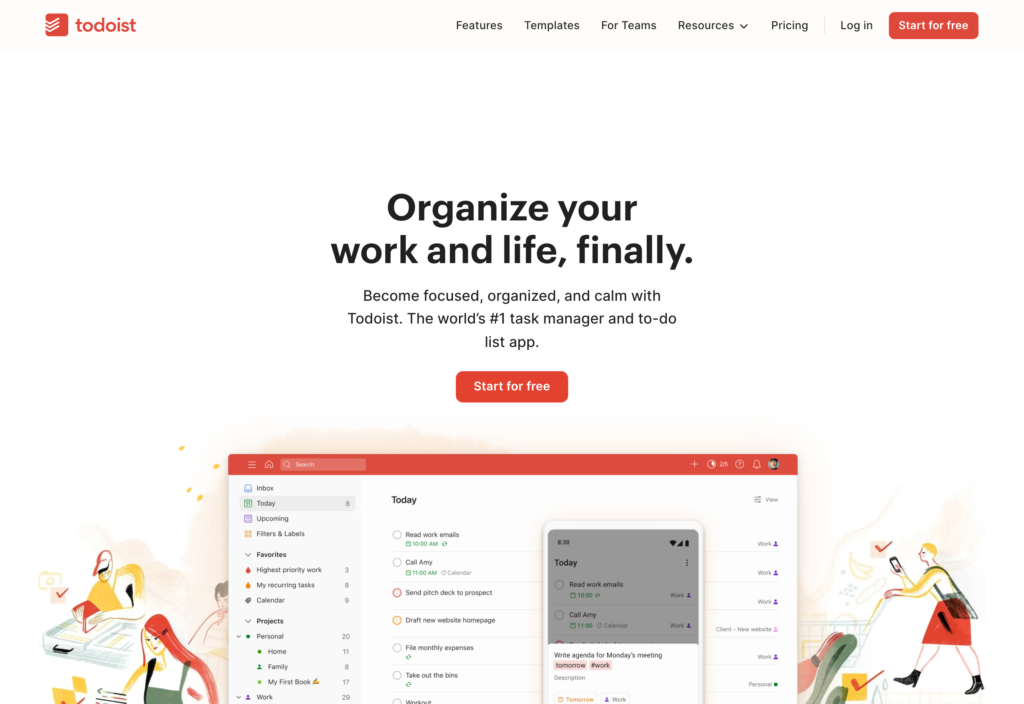
Key Features
- Project templates
- Customizable task views
- File uploads, including voice notes
- Weekly and monthly productivity visualizations
Pros
- Free version
- Easy-to-use app
Cons
- Per-user pricing can become expensive
- Reminders available only with paid plans
The final alternative to Trello in our roundup is Todoist. It’s a task management software that lets users create digital task lists for their professional or personal projects. Tasks can be created manually, using templates, or by linking Todoist with users’ personal emails or calendars. Users are also able to assign others to certain tasks and upload files to tasks.
In addition, Todoist allows users to break lists down into subtasks and assign priorities. They can filter views to organize tasks by due date, project, or person responsible for it. Plus, there’s the option to add comments to lists and share them with team members. Todoist also gives users an overview of their daily to-do items and upcoming tasks.
Furthermore, Todoist’s Pro plan enables users to set up notifications to remind them of important tasks and deadlines. This feature isn’t available on any lower-tier plans, however.
Pricing
Starts at $150/month, for 50 users Trial: Yes Free Plan: Yes
Compare the Best Trello Alternatives for Project Managements
| Topic |
 Start for free
Start for free
|
|

|

|

|

|

|
|---|---|---|---|---|---|---|---|
| Reviews |
4.8
|
4.5
|
4.6
|
4.6
|
4.3
|
4.7
|
4.6
|
| Pricing |
Starts at just $29/month for the first 30 users
|
Starts at $10.99/user/month
|
Starts at $8/user/month
|
Starts at $10/member/month
|
Starts at $15/user/month
|
Starts at $10 per, user per month
|
Starts at $150/month, for 50 users
|
| Free Trial |
yes
14-day
|
no
|
yes
|
yes
15-days
|
yes
30-75 days
|
yes
|
yes
|
| Free Plan |
yes
Free Up to 10 users
|
yes
Up to 15 people
|
yes
|
yes
|
yes
For one project
|
yes
|
yes
|
| Use cases |
The best alternative to Trello
|
|
|
|
|
Good for: Managing large amounts of data
|
|
| Available on |
Web, iOS, Android, Windows, Mac
|
Summary
Trello is a popular project and task management software, but it’s not the perfect solution for every business. Some users find that its simplicity may not cater to more complex project needs. Meanwhile, others have commented on the cost of Trello, particularly for larger teams.
While there are various Trello competitors out there, Connecteam is the best alternative. Connecteam gives you access to customizable task management, collaboration, and communication tools, all from a single app.
With a free-forever Small Business Plan and paid plans starting as low as $29 per month, Connecteam is also a more affordable solution than Trello.
Get started with Connecteam for free today and manage your business, projects, and tasks more efficiently.



